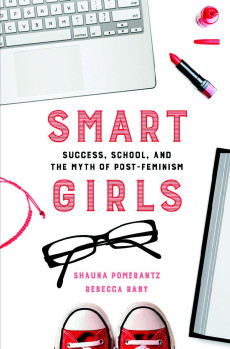
Smart Girls: Success, School, and the Myth of Post-Feminism
Shauna Pomerantz & Rebecca Raby
272 pages, University of California Press, 2017
Pop icon Beyoncé challenging the patriarchy at the Super Bowl halftime show; pregnant technology company CEOs; media headlines screaming that women academically outpace their male peers: Given all this, it’s easy to postulate that the age of post-feminism has arrived. So when I was invited to review Smart Girls: Success, School, and the Myth of Post-Feminism, I was intrigued.
The coauthors, professors of child and youth studies at Brock University in Ontario, set out an ambitious agenda to deconstruct the idea of “an endless parade of young women who epitomize ubiquitous, seemingly effortless success.” Their fiveyear scholarly study examines 57 girls and 17 boys from Canada, aged 12 to 17, through multiple one-on-one and group interviews. Four themes particularly support the authors’ hypothesis that post-feminism is a myth:
Mental health | Many of the girls shared personal accounts of missing sleep and food, experiencing significant stress, and even struggling with serious mental health issues in order to continuously achieve excellence across multiple dimensions. The authors cite multiple studies that point to elevated levels of depression, anxiety, and eating disorders in young girls, compared with young boys.
Identity crisis | It was striking to learn that the family-versus-career dilemma confronts even very young women for whom both motherhood and a career may be a decade or more away. Wren, one of the girls interviewed, commented, “I think girls have the immanent, ‘Am I going to be a mom, am I going to travel, be a mom, go to university, am I going to do this? Am I going to do that?’ ” The authors’ conversations with many other young girls echoed these concerns, which were absent in the discussions with boys.
Physical appearance | Even the most accomplished young women in the study commented on pressures to counterbalance being intellectual with being physically attractive and fashionable: “Jordan felt that there was a premium placed on being pretty rather than smart, suggesting that it was more important to cultivate a certain kind of femininity than it was to be a strong student.” The authors refer to scholar Angela McRobbie’s “post-feminist masquerade” theory, which argues that women create a “physical buffer” to downplay their own successes through conspicuous consumption and their own objectification. Again, this pressure was absent in discussions with young boys, who at times felt there were benefits associated with being less groomed.
Social validation | Many young women felt extreme pressure to “collect friends” for social validation. Most girls alluded to an overwhelming pressure to be “happy, positive, and fun,” and to ensure that any sadness or stress was hidden. The young boys in the study did not express a similar need.
While the voices of young women and men lend authenticity to Smart Girls, databased evidence is largely absent. Such analysis may have helped supplement the themes that the book explores. The fi ve-year study length also could have aff orded the authors an opportunity to track the evolution of each subject and to explore how her or his views, struggles, and opportunities evolved over time. Instead, the book presents many interviewees at just one point in time, and so the reader is not able to learn from each individual’s full range of experience.
The reliance on interviews with a small group of largely middle-class adolescents in Canada may be part of the reason the book fails to explore more deeply how cultural forces—such as the media and consumerism— undermine the political gains of many young women. The young girls’ challenges noted in the book may be rooted in what Andi Zeisler, founder of the feminist firm Bitch Media, calls “marketplace feminism”: a “cool, fun, accessible identity, characterized by style and attitudes, that is, in the end, depoliticized.” The emergence of such new, gender-based barriers is an underlying theme that never quite surfaces in Smart Girls.
In fact, the young women in the study are so firmly focused on the barriers they face in achieving a “winning feminized persona” that they do not question the validity of that goal itself. They are largely impervious to structural gender-based challenges, in areas such as access to equal education, health care, or extracurricular opportunities. These challenges include the well-documented prevailing perception among teachers that boys are more gifted in STEM subjects and therefore warrant more attention; an everrising rape and sexual assault culture on campuses; continued encroachments on Planned Parenthood and sexual education; and notable gender inequality in high school and college sports. The book’s lack of focused discussion on these topics is alarming.
Overall, however, Smart Girls has a powerful message that is often overlooked in mainstream media today: that feminism must not rest on its laurels. Instead, we must continue to intentionally focus resources and political action to support the political, economic, personal, and social rights of girls and women. De-emphasizing the unrealistic and superfi cial goals of “marketplace feminism” and addressing unconscious bias in the education system are just two examples of how we can truly usher in a post-feminist era.

